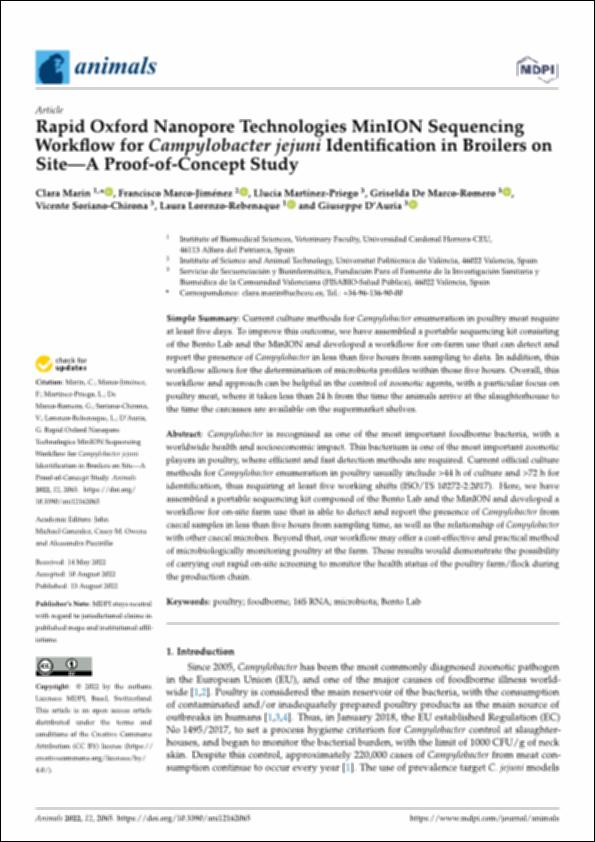Please use this identifier to cite or link to this item:
http://hdl.handle.net/10637/14254Rapid Oxford Nanopore Technologies MinION sequencing workflow for "Campylobacter jejuni" identification in broilers on site : a proof-of-concept study
| Title: | Rapid Oxford Nanopore Technologies MinION sequencing workflow for "Campylobacter jejuni" identification in broilers on site : a proof-of-concept study |
| Authors : | Marín Orenga, Clara Marco Jiménez, Francisco Martínez Priego, Llúcia Marco Romero, Griselda de Soriano Chirona, Vicente Lorenzo Rebenaque, Laura Auria, Giuseppe d' |
| Keywords: | Food - Quality.; Alimentos - Control de calidad.; Veterinary bacteriology.; Carne de ave - Medidas de seguridad.; Pollos - Enfermedades infecciosas - Control.; Bacteriología veterinaria.; Poultry - Safety measures.; Chickens - Communicable diseases - Control. |
| Publisher: | MDPI |
| Citation: | Marin, C., Marco-Jiménez, F., Martínez-Priego, L., De Marco-Romero, G., Soriano-Chirona, V., Lorenzo-Rebenaque, L., & D'Auria, G. (2022). Rapid Oxford Nanopore Technologies MinION sequencing workflow for "Campylobacter jejuni" identification in broilers on site : a proof-of-concept study. Animals, vol. 12, i. 16 (13 aug.), art. 2065. DOI: https://doi.org/10.3390/ani12162065 |
| Abstract: | Campylobacter is recognised as one of the most important foodborne bacteria, with a worldwide health and socioeconomic impact. This bacterium is one of the most important zoonotic players in poultry, where efficient and fast detection methods are required. Current official culture methods for Campylobacter enumeration in poultry usually include >44 h of culture and >72 h for identification, thus requiring at least five working shifts (ISO/TS 10272-2:2017). Here, we have assembled a portable sequencing kit composed of the Bento Lab and the MinION and developed a workflow for on-site farm use that is able to detect and report the presence of Campylobacter from caecal samples in less than five hours from sampling time, as well as the relationship of Campylobacter with other caecal microbes. Beyond that, our workflow may offer a cost-effective and practical method of microbiologically monitoring poultry at the farm. These results would demonstrate the possibility of carrying out rapid on-site screening to monitor the health status of the poultry farm/flock during the production chain. |
| Description: | Este artículo se encuentra disponible en la siguiente URL: https://www.mdpi.com/2076-2615/12/16/2065 Este artículo de investigación pertenece a la colección "Current Advances in Poultry Research". |
| URI: | http://hdl.handle.net/10637/14254 |
| Rights : | http://creativecommons.org/licenses/by/4.0/deed.es |
| ISSN: | 2076-2615 (Electrónico) |
| Language: | es |
| Issue Date: | 13-Aug-2022 |
| Center : | Universidad Cardenal Herrera-CEU |
| Appears in Collections: | Dpto. Producción y Sanidad Animal, Salud Pública Veterinaria y Ciencia y Tecnología de los Alimentos |
Items in DSpace are protected by copyright, with all rights reserved, unless otherwise indicated.


